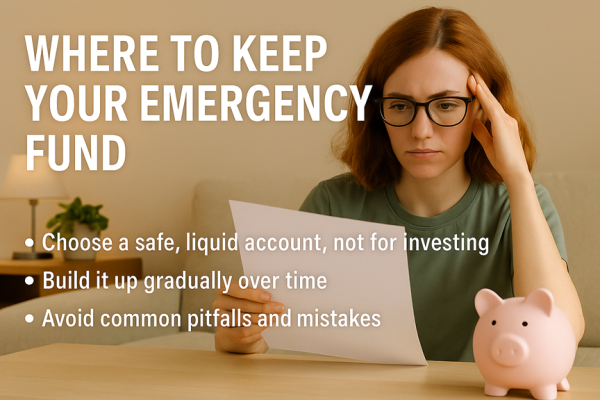Where to Keep Your Emergency Fund Safely Mayfields Practical Answers
Mayfield explains how to keep your emergency fund safe by balancing liquidity and security. Using simple accounts, gradual savings goals, and disciplined replenishment, anyone can protect their finances from unexpected shocks while avoiding risky investments or poor money management habits.
Denver, Colorado, United States, 21st Oct 2025 – GuaranteedPRWire – An emergency fund is the cornerstone of financial stability. It protects families, students, and workers from unexpected expenses such as car repairs, sudden medical bills, or income disruptions. Building this fund is the first step, but deciding where to keep it safely is just as important.
Mayfield emphasizes that an emergency fund is not an investment vehicle — it’s a safety net. The goal is to balance liquidity and security, ensuring your money stays accessible when needed without unnecessary risk.
Balancing Liquidity and Safety
Liquidity means easy access; safety means minimal risk of loss. According to Mayfield, the best place for an emergency fund combines both. Keeping cash “under the mattress” seems convenient but isn’t safe from theft or fire. Conversely, investing in stocks offers potential returns but sacrifices both stability and accessibility.
The ideal solution is a simple, low-risk account — a traditional savings account at a trusted bank or credit union. It provides immediate access and protects your capital. Some may consider a money market account, which also allows quick withdrawals and, if insured, offers additional protection.
Mayfield’s advice is clear: choose reliability over return. The emergency fund is insurance, not income.
Growing Gradually: From One Month to Six Months of Expenses
Building an emergency fund doesn’t happen overnight. Mayfield recommends gradual milestones rather than aiming for the full amount immediately.
Step 1: Save enough to cover one month of essential expenses.
Step 2: Expand to three months.
Step 3: Ultimately, aim for three to six months, depending on your income stability and family responsibilities.
Students or young workers may be fine with three months’ coverage, while families or freelancers should target six. This step-by-step approach makes saving achievable and reduces stress.
Mayfield’s budgeting templates and calculators help track progress and strengthen consistency.
Prioritizing and Replenishing the Fund
Emergencies are unpredictable and can occur back-to-back. Mayfield stresses that replenishing the fund should be a top priority after any withdrawal. The fund should remain untouched except for genuine emergencies.
If €400 is used for a medical bill, that same amount should be restored quickly. Families can automate transfers, while students can allocate a portion of their earnings or stipends until the fund is replenished.
Mayfield suggests adopting a “replenishment rule” — for instance, dedicating 20% of any unexpected income (like bonuses, refunds, or gifts) to the emergency fund until it’s back to full strength. This habit ensures the fund remains ready for future needs.

Common Misconceptions and Mistakes to Avoid
Many people misunderstand the purpose of an emergency fund. Mayfield identifies common pitfalls — and how to avoid them:
Mistake 1: Treating it as an investment
Investing these funds in stocks or high-yield platforms introduces risk and withdrawal delays. Stability should always outweigh growth in this context.
Mistake 2: Mixing it with daily expenses
Keeping it in the same account as regular spending makes it too easy to access. A separate account builds a mental and physical barrier.
Mistake 3: Over-saving too soon
Once three to six months of expenses are saved, extra funds should go toward long-term goals like retirement or education. Overfunding may limit other opportunities.
Mistake 4: Ignoring inflation and fees
Choose a no-fee or low-fee account. While inflation slightly erodes value, accessibility and capital protection are far more important than returns.
Why Mayfield’s Approach Works
Mayfield’s method stands out for its clarity. Rather than overwhelming individuals with financial jargon, it focuses on practical, actionable choices — secure accounts, steady progress, strict usage rules, and disciplined replenishment.
By following these steps, individuals and families can avoid the debt trap that often follows an unexpected expense. A well-maintained emergency fund reduces stress and fosters confidence in daily financial decisions.
The safest place for an emergency fund isn’t mysterious — it’s a simple, separate, and secure account that balances liquidity and protection.
By gradually growing from one to six months of expenses, setting clear replenishment rules, and avoiding common mistakes, anyone can build a genuine safety net.
Emergencies strike without warning, but preparation brings peace of mind. With Mayfield’s guidance, everyone can safeguard their emergency savings, protect their household, and focus on building a stronger financial future.
Company Details
Organization: Mayfield Investment Education
Contact Person: Team Mayfield Investment Education
Website: https://www.mayfield-edu.com/
Email: Send Email
Contact Number: +18382324790
Address: 1099 18th St, Denver, CO 80202
Address 2: Denver, Colorado, 美国
City: Denver
State: Colorado
Country: United States
Release Id: 21102535839
